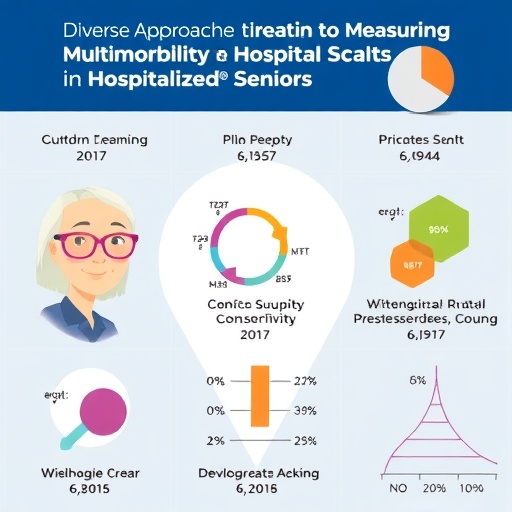Exploring Multimorbidity: Understanding Its Impact on Hospitalization in Older Adults
The field of geriatrics continues to expand, as researchers delve into the complexities of aging, particularly the multifaceted nature of health conditions among older adults. Recently, a significant study led by E.A. Silveira and colleagues has drawn attention to the variations in multimorbidity measurements, especially in the context of hospitalization events. Multimorbidity, defined as the coexistence of multiple chronic conditions, poses profound challenges for healthcare systems and significantly affects the quality of life of elderly patients.
In the systematic review published in BMC Geriatrics, the researchers meticulously analyzed various methodologies employed in studies addressing hospitalization among older adults. The findings underscore the discrepancies and inconsistencies in how multimorbidity is measured and reported across different research. These variances not only reflect on individual studies but may also influence healthcare policies, resource allocation, and patient care strategies at a larger scale.
Understanding the implications of multimorbidity is vital, particularly as the global population ages. The World Health Organization has forecasted that by 2050, older adults will constitute a substantial portion of the population, thus increasing the prevalence of chronic diseases and, consequently, multimorbidity. This demographic shift necessitates a more integrated approach in research, focusing on precision in measurement that can guide effective interventions for older adults.
The systematic review gathered data from multiple studies that identified different metrics and frameworks for assessing multimorbidity. Notably, some researchers utilized the commonly accepted Charlson Comorbidity Index while others employed various counting systems that aggregate chronic conditions. Each approach offers unique insights yet introduces its own biases and limitations. Understanding these nuances is critical for drawing reliable conclusions and implementing actionable health care practices.
One of the glaring issues identified by Silveira et al. was the lack of consensus on a standardized definition of multimorbidity among researchers. This absence of uniformity leads to discrepancies in data interpretation and results generation, complicating the collective understanding of how multimorbidity affects hospitalization rates. For example, an elderly patient classified with multimorbidity in one study may not be recognized as such in another, affecting the perceived health risks and care approaches recommended by healthcare providers.
The implications extend beyond mere definitions; how multimorbidity is quantified can have significant ramifications for clinical practices. Health care providers must navigate a myriad of conditions while formulating treatment plans for elderly patients. A clearer understanding of multimorbidity through standardized measures could enhance clinical decision-making, potentially reducing hospital admissions linked to preventable complications of chronic illnesses.
Moreover, the review by Silveira and colleagues stresses the importance of patient-centered approaches in managing multimorbidity. Healthcare systems must recognize that older adults experience health conditions uniquely, with varying impacts on their daily lives. By focusing on the holistic view of an individual’s health status rather than isolated conditions, providers can devise more effective strategies for managing care and improving quality of life.
Another critical dimension explored in this study is the impact of social determinants of health on multimorbidity and hospitalization patterns. Factors such as socioeconomic status, access to healthcare, social support networks, and environmental conditions play a pivotal role in the health outcomes of older adults. Recognizing these factors can lead to more tailored interventions that address not just the medical needs but the broader health contexts of patients.
Furthermore, the review highlights the pressing need for longitudinal studies that track the health trajectories of older adults over time. Such research could illuminate how different multimorbidity patterns emerge, evolve, and influence hospitalization. In doing so, healthcare systems could develop proactive measures that anticipate health declines rather than reactively addressing crises in care.
The findings of this systematic review also pose new questions for future research. How can health technology be leveraged to improve the assessment and management of multimorbidity? As telehealth and digital health tools gain momentum, integrating these technologies into the holistic management of older adults’ health could significantly enhance both monitoring and intervention capabilities. Innovative approaches must be explored to provide real-time data, ensuring that interventions remain responsive and relevant.
Additionally, there’s an opportunity for policy discussions to take place, aimed at bridging the gaps in multimorbidity research. By fostering collaborations among researchers, healthcare providers, and policymakers, stakeholders can aim to create a more robust framework for multimorbidity that serves the health needs of older adults effectively. This multidisciplinary approach promises to ensure that research translates into meaningful changes within healthcare systems.
In conclusion, the systematic review conducted by Silveira et al. serves as a clarion call to the medical community to address the complexities of multimorbidity in older adults comprehensively. By advocating for cohesive definitions, patient-centered methodologies, and inclusivity of social determinants, the healthcare landscape can better accommodate the needs of those it serves. The ongoing evolution of our understanding of multimorbidity will be pivotal in shaping future healthcare strategies, particularly as we face one of the most significant transitions in public health demographics.
This study represents a vital contribution to the discourse on aging and healthcare. It emphasizes that as we enhance our understanding of multimorbidity, we are better equipped to address the healthcare challenges of the future. With collaboration, innovation, and a commitment to patient care, the medical community can forge a path toward improved health outcomes for aging populations.
Subject of Research: Multimorbidity measurement in hospitalisation studies of older adults
Article Title: Variations in multimorbidity measurement in studies evaluating hospitalisation in older adults: a systematic review
Article References: Silveira, E.A., de Oliveira Rezende, A.T., Rodrigues, L.P. et al. Variations in multimorbidity measurement in studies evaluating hospitalisation in older adults: a systematic review. BMC Geriatr 25, 857 (2025). https://doi.org/10.1186/s12877-025-05964-z
Image Credits: AI Generated
DOI: https://doi.org/10.1186/s12877-025-05964-z
Keywords: Multimorbidity, older adults, hospitalization, healthcare, chronic conditions, systematic review, health outcomes.




